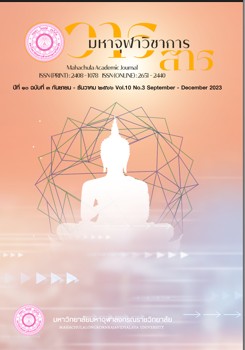An Analytical Study of Learner (Sekhaa Puggala) in Buddhist Scriptures
Main Article Content
Abstract
This thesis has 3 objectives: 1) to study the learner (Sekkha) in the Buddhist scriptures, 2) to study the practical ways of the learner, and 3) to analyze the destruction of defilement done by the learner in Buddhist scriptures. This research employed the documentary research methodology done by studying Tipitฺaka, commentaries and related Buddhist scriptures.
The research results showed that the meaning of the learner or ‘Sekkha’ basically means an Anu-Buddha or Noble one who needs to study the threefold-training, chastity and follows the 37 principles of Bodhipakkhiyadhamma. In this, the learner embraces the followings: Sotapattimagga, Sotapattiphala, Sakadãgãmimagga, Sakadãgãmiphala, Anãgãmimagga, Anãgãmiphala, and Arahattamagga. The element of enlightenment is the association of wise persons, listening to the Buddha, Yonisomanasikãra and observing the proper Dhamma. It is said that the learner possesses the following qualities: he has faith in the Buddha, strongly believing in the Dhamma, Sangha where the precepts are always observed. The Stream-enterer will be born not more than seven births, Once-returner only one, Non-returner none and the Worthy One will be qualified as ‘Asekkha’ meaning one who does not require any further training moving toward Nibbãna respectively. The practical ways of the learner need precepts, controlling the sense-faculties, moderation in consumption, making an effort, obtaining the Dhamma and absorption. In this respect, on the one hand, the things that cause the decline of the attainment of the Path and its result are of laziness in working, talking, sleeping, mingling with a group of people, on the other hand, the things that give rise to the prosperity leading to the Path and its result refer to controlling of sense-faculties, moderation in consumption, proper activities and the Dhammas landing man in the attainment of Sekkha mean four types of foundations of mindfulness, seven kinds of virtues leading to the enlightenment. The merit that should be done to Sekkha points to what he should be treated by respect and welcome, offering and worship as he becomes the proper place of the world. When it comes to the analysis of abandoning of the defilement made by Sekkha, it was found that the Stream-enterer destroys Sakãyaditthi, Vicikichã, and Sĩlapbataparãmãsa the Once-Returner Sakadãgãmĩ and defilements, namely Sakãyaditthi, Vicikichã, Sĩlapbataparãmãsa, alleviating three kinds of uncharities, the Non-Returner destroys defilements: Sakãyaditthi, Vicikichã, Sĩlapbataparãmãsa, kãmarãga, Dosa and the Worthy One completely destroys Lobba, Dosa, Moha, Mãna, Ditthi, Vicikichã, Thĩna, Uddhacca, Ahirika, and Anottappa.
Article Details

This work is licensed under a Creative Commons Attribution-NonCommercial-NoDerivatives 4.0 International License.
References
จุทาภัค หริรักษ์ธำรง. “รูปแบบการบรรลุธรรมในพระพุทธศาสนาเถรวาท”. ดุษฎีนิพนธ์พุทธศาสตรดุษฎีบัณฑิต. บัณฑิตวิทยาลัย: มหาวิทยาลัยมหาจุฬาลงกรณราชวิทยาลัย, ๒๕๖๑.
พระธรรมปิฎก (ป. อ. ปยุตฺโต). พจนานุกรมพุทธศาสตร์ ฉบับประมวลธรรม. กรุงเทพมหานคร: โรงพิมพ์มหาจุฬาลงกรณราชวิทยาลัย, ๒๕๔๐.
พระพรหมคุณาภรณ์ (ป. อ. ปยุตฺโต). พุทธธรรม ฉบับปรับขยาย. พิมพ์ครั้งที่ ๓๕. กรุงเทพมหานคร: สำนักพิมพ์ผลิธัมม์, ๒๕๑๑.
พระมหาคำสิงห์ สีหนนฺโท (กองเกิด). “การศึกษาวิเคราะห์เรื่องอริยปฏิปทาในคัมภีร์พระพุทธศาสนา”. ดุษฎีนิพนธ์พุทธศาสตรดุษฎีบัณฑิต. บัณฑิตวิทยาลัย: มหาวิทยาลัยมหาจุฬาลงกรณราชวิทยาลัย, ๒๕๖๓.
แม่ชีพิมพ์วรา ทิพยบุลสิทธิ์. “การศึกษาวิชชาและจรณะในเสขปฏิปทาสูตร”. วิทยานิพนธ์พุทธศาสตรมหาบัณฑิต. บัณฑิตวิทยาลัย: มหาวิทยาลัยมหาจุฬาลงกรณราชวิทยาลัย, ๒๕๕๕.
มหาจุฬาลงกรณราชวิทยาลัย. พระไตรปิฎกภาษาบาลี ฉบับมหาจุฬาเตปิฏกํ ๒๕๐๐. กรุงเทพมหานคร: โรงพิมพ์มหาจุฬาลงกรณราชวิทยาลัย, ๒๕๓๕.
________. พระไตรปิฎกภาษาไทย ฉบับมหาจุฬาลงกรณราชวิทยาลัย. กรุงเทพมหานคร: โรงพิมพ์มหาจุฬาลงกรณราชวิทยาลัย, ๒๕๓๙.
สมเด็จพระพุทธโฆษาจารย์ (ป. อ. ปยุตฺโต). พจนานุกรมพุทธศาสน์ ฉบับประมวลศัพท์. พิมพ์ครั้งที่ ๓๓. กรุงเทพมหานคร: สำนักพิมพ์ผลิธัมม์, ๒๕๖๑.
สมบูรณ์ ตาสนธิ. “กระบวนการและขั้นตอนบรรลุอริยสัจ ๔ ของพระอริยบุคคล”. ดุษฎีนิพนธ์พุทธศาสตรดุษฎีบัณฑิต. บัณฑิตวิทยาลัย: มหาวิทยาลัยมหาจุฬาลงกรณราชวิทยาลัย, ๒๕๖๐.
สานุ มหัทธนาดุลย์. “การศึกษาวิเคราะห์สังโยชน์ในคัมภีร์พระพุทธศาสนาเถรวาท”. วิทยานิพนธ์พุทธศาสตรมหาบัณฑิต. บัณฑิตวิทยาลัย: มหาวิทยาลัยมหาจุฬาลงกรณราชวิทยาลัย, ๒๕๕๓.


